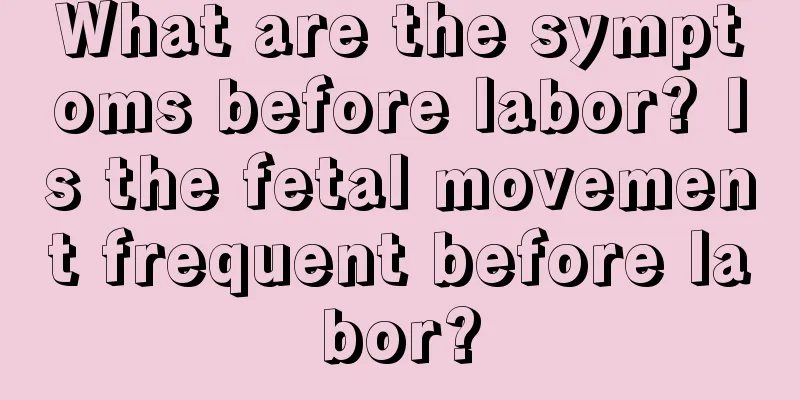What is the reason for the white coating on the baby's tongue? Can babies eat hawthorn slices?

|
People who pay attention to health care must know that a person's physical health can be judged by the tongue coating. The color of each person's tongue coating is different, which represents each person's physical condition. So what is the reason for the baby's tongue coating to be white? Can babies eat hawthorn slices? What is the reason for the baby's tongue coating to be white?1. If you find white spots on your baby's tongue and lips, there may be worms in the baby's stomach; 2. When there is stomach disease caused by indigestion, food accumulation, cough and phlegm, the tongue coating will become thick and greasy; 3. When a child catches a cold, especially in the early stages of a cold, a thick layer of white fur will appear on the tongue. As the cold progresses, the tongue fur will turn yellow, indicating that the heat is more obvious; 4. When a child is dehydrated due to diarrhea or has a persistent high fever, a dry tongue coating will appear; 5. Some allergic diseases may cause a map-like tongue coating or peeling tongue coating; 6. Black tongue coating that is dry and looks like cracked river bottom often appears in seriously ill children with long-term high fever. Can babies eat hawthorn slices?Hawthorn slices contain multiple vitamins and have high nutritional value. Hawthorn slices can promote digestion and can be given to babies in small amounts. But don't eat too much. Hawthorn slices and fruit danpi contain a lot of sugar. If babies eat too much, their blood sugar will remain at a high level, and they will not feel hungry, which will affect their eating. Long-term and large-scale consumption will lead to malnutrition, anemia, etc. After eating, you must pay attention to rinsing your mouth and brushing your teeth in time to prevent damage to your teeth. Some parents often let their children eat hawthorn, thinking that hawthorn can promote gastric juice secretion and help digestion of food. However, nutrition experts point out that eating too much hawthorn is not good for children's health. Babies aged one and a half can eat hawthorn slices in moderation, but it is still recommended that babies start eating hawthorn slices from the age of 2. Eating a moderate amount can also help digestion, but excessive use will cause excessive gastric acid and stomach discomfort. Therefore, it is necessary to use less of this food to aid digestion, but excessive use will cause excessive gastric acid, and severe cases will cause stomach pain and acid reflux, so it should be used less. You can eat it every day, but it is best to eat a few slices a day. Too much will easily cause abdominal pain and diarrhea. Hawthorn contains a compound called vitexin, which has anti-cancer effects. Nitrosamines and aflatoxin can induce the occurrence or aggravation of digestive tract cancer, and experimental studies have shown that hawthorn extract can not only block the synthesis of nitrosamines, but also inhibit the carcinogenic effect of aflatoxin. Therefore, people at high risk of digestive tract cancer should eat hawthorn frequently. For patients who already have cancer, if they have indigestion, they can also cook porridge with hawthorn and rice to eat, which can not only help digestion, but also play an auxiliary anti-cancer role. What do different tongue coating colors mean?1. White fur: Generally indicates superficial symptoms and cold symptoms. A thin, white and moist tongue fur is a normal tongue fur. At the same time, a thin, white fur also indicates that the disease is on the surface of the body and has not entered the body. A thin, white and overly lubricated tongue fur is often seen in superficial cold symptoms. A thin, white and dry fur is a superficial heat syndrome or a dry pathogen. A thick, white and dry tongue fur represents dampness and heat damage to body fluids. A tongue fur covered with white fur that is not dry to the touch is called "powdery white fur", indicating plague. A white and dry fur is called "rough and cracked fur", which is often seen in febrile diseases. A pale tongue with a white and smooth fur represents cold symptoms or cold-dampness syndrome. A white, slippery and sticky tongue fur is seen in phlegm and dampness in the body or dampness trapped in the spleen. A white, slippery and rotten tongue fur indicates heat accumulation in the stomach. If the fur is white like snowflakes and dry, it is called "snowflake fur", indicating a cold spleen. The tongue and mouth are covered with raw clothes, and moldy fur or erosion spots appear, which is a dangerous sign of stomach qi decline and internal qi extinction. 2. Yellow tongue coating: Yellow tongue coating indicates internal heat syndrome. A thin, yellow and dry tongue coating indicates excessive internal heat and loss of body fluids. A yellow, dry and prickly tongue coating with cracks indicates extreme internal heat, severe loss of body fluids and severe heat in the internal organs. A thick and greasy yellow tongue coating indicates phlegm heat, food accumulation or internal dampness and heat. A yellow, smooth and moist tongue coating indicates yang deficiency. 3. Gray fur: Mainly for internal symptoms. Gray and thin fur is smooth, mostly for internal cold and dampness, or phlegm and fluid retention. Gray and dry fur is for fever or yin deficiency and hyperactivity of fire. 4. Black tongue coating: Black tongue coating is mostly transformed from yellow tongue coating or gray tongue coating, indicating that the condition is extremely serious. Black and dry tongue coating indicates excessive heat and deficiency of body fluid. Black and dry tongue coating on the tip of the tongue indicates excessive heart fire. Black and smooth tongue coating indicates extreme yang deficiency and yin cold. What is the reason for the white tongue coating of newbornsActually, it doesn't matter. All newborn babies are like that. The baby's gastrointestinal system is growing, and the digestive function is not very good. (Pay attention to observe whether the baby farts a lot. If there are a lot and there is always a gurgling sound in the stomach, it is poor liquefaction.) You must drink more water and master the feeding time. You can't feed when you are hungry. At one month old, you must feed regularly every 3-4 hours and drink more water in between. The amount of water a baby needs to be fed every day is based on weight. 1 kg needs 30ML of water per day. Burping is because the child's diaphragm is not well developed. It doesn't matter. It will get better naturally when it grows up. My baby also had these symptoms when he was one month old. He had to burp for 4-5 minutes every time. It was very long. I asked the doctor and he said it was okay. Don't let the child catch a cold. If he catches a cold, he will always burp. And you must hold him up and burp him after feeding. This is a must and can't be forgotten. |
<<: What should I do if my child often catches a cold? How can I improve my child's immunity?
>>: Will pregnancy spots disappear after giving birth? What are pregnancy spots?
Recommend
How to treat indigestion in children? What to eat for indigestion in children
Usually children's stomachs are very fragile ...
Can pears be eaten on an empty stomach? What will happen if you eat pears on an empty stomach?
Pear is a fruit with rich nutritional value, whic...
What tests should be done when you are pregnant with your second child? 6 tests that you must do when you are pregnant with your second child
Now that the second-child policy has been opened,...
Why do foreigners like to adopt Chinese children? There are many abandoned babies in China
In China, many children are abandoned by their pa...
Can Lion toothpaste remove smoke stains? Advantages of Lion toothpaste
People who smoke for a long time will have yellow...
How long does it take to cut a newborn's hair? Can a newborn's hair be cut?
Newborns are very fragile, and many of their dail...
How old is the baby suitable for wearing underwear? What are the benefits of wearing underwear for babies?
In real life, many people think that babies are s...
What kind of soup is good to drink in early pregnancy? What are the common soups for abortion?
Everyone must have heard a lot of common sense in...
Will I have stomach pain in early pregnancy? Causes of stomach pain in early pregnancy
Pregnant women are a very special group. They sho...
What are the symptoms of iodine deficiency in babies? What foods are good for babies to eat to supplement iodine?
Iodine is very important to the human body. If it...
Do I need to cover my baby with a blanket when he wears a sleeping bag? What should my baby wear inside a sleeping bag?
Nowadays, many families buy sleeping bags for the...
How to choose infant formula? Which kind of formula is better?
There are many varieties of milk powder on the ma...
What are the symptoms of baby getting angry? See how to care for it with Chinese and Western medicine
Maybe one day you suddenly find out why your baby...
How long after giving birth can you lose weight? The most effective way to lose weight after giving birth
After ten months of pregnancy, I finally gave bir...
Can Shanghai sulfur soap be used to wash your face and remove acne? The efficacy and function of Shanghai sulfur soap
Shanghai Sulfur Soap is an old brand that every h...









